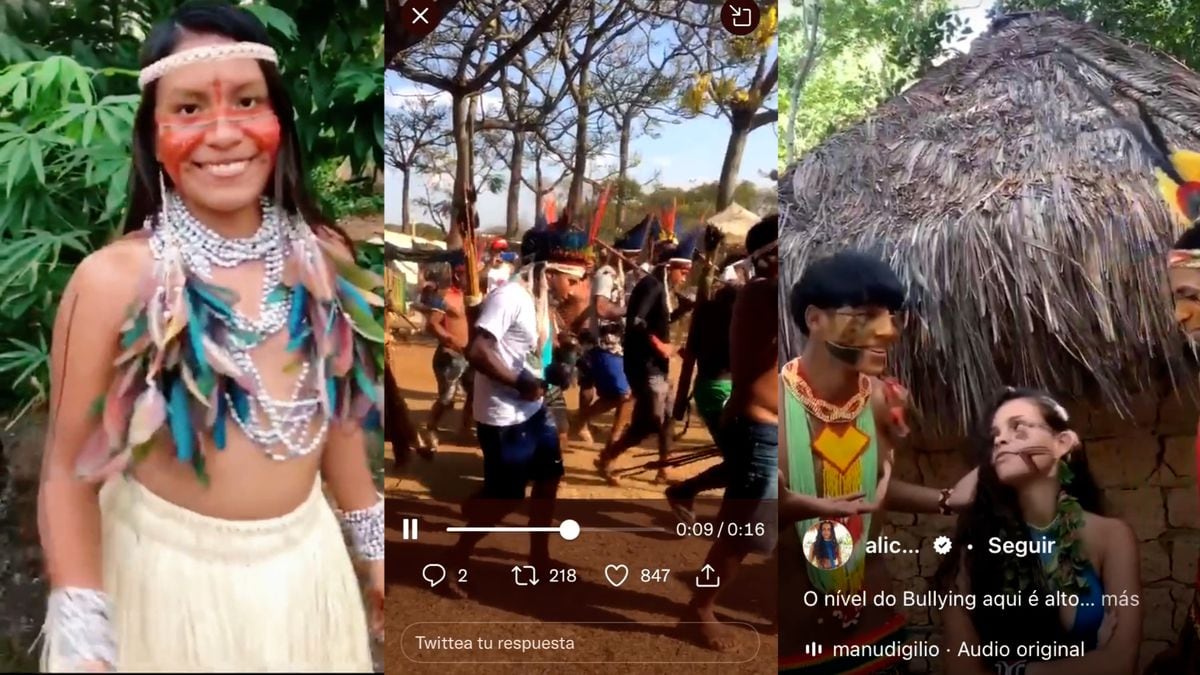Sometimes globalization melds into recently unimaginable phenomena such as the interest of Iranians in photographing themselves with Western tourists to post the photo as a trophy on Instagram, that astronauts can tweet a photo while they are in orbit or that the latest Brazilian sensation of TikTok lives in one of the most remote places in the country. Cunhaporanga Tatuyo is an indigenous woman who is 22 years old and has six million followers on the very short video network that is all the rage among teenagers around the world. The formula? Tell his daily life in a village in the deepest part of the Amazon. That includes insects, face paintings and feather pendants as well as an Internet connection in the rainforest and a mobile phone.
A good part of the attractiveness of the young woman is that she combines the image that the world has of the Amazonian indigenous people with the popular culture of those her age, whether they live in Bagdad, Stockholm, Beijing or the village of the Tatuyo indigenous community.
Wearing a straw T-shirt or skirt, sometimes with elaborate drawings on the face to ward off spirits, his videos are basically playful.
He brightens up the scene with all kinds of filters and makes him sing famous ballads.
Other indigenous people also proliferate in Brazil, such as Karibuxi or Alice Pataxó, who have found the perfect ecosystem to defend their cause on social media.
They have tens of thousands of followers.
The video uploaded by Cunhaporanga this Thursday to TikTok starts with a huge pot full of insects that look like ants of a scary size.
Living bugs, on the move.
After roasting them over the fire, a kid smiles at the camera with one on his tongue and several more in the palm of his hand.
More than 92,000 visits had on Friday afternoon.
The videos in which, in the Portuguese that he had to learn at school, he teaches words in his language are also successful.
The young woman, called Maira Gomez Godinho, has opened a window to a world as far away as it is unknown that arouses enormous curiosity.
It has seven times more followers than the official figure for indigenous Brazilians.
Getting to the tiktokera hut from Rio or São Paulo requires taking two or three planes and sailing an hour upstream of the Negro River from São Gabriel da Cachoeira.
Cunhaporanga has told the
Washington Post
, who visited her in her village, that she was one of the many millions of anonymous and nondescript TikTok users who even recorded herself eating a daily food among her own, a larva. Vivid, yellowish, plump, the size of a pinkie. How to replicate on a global scale the effect that grasshoppers, mussels or elvers have on some foreigners: disgust and curiosity ... but, of course, supervitamin, like everything on TikTok. There the phenomenon began to germinate. In the aforementioned report, he explains that, of the larva, only the body is eaten, not the head, and it is accompanied with a handful of cassava flour. Ah! They say it tastes like coconut.
No other country is as hooked on the Internet as Brazil. From President Bolsonaro to the last of the citizens. Rio Mayor Eduardo Paes recently tweeted an international OECD statistic that said that Brazilians spend an average of 9.3 hours a day on the Internet, half of them browsing social networks.
The indigenous people of Brazil came to the conclusion long ago that it is a place where they have to be, an ideal space to fight. This week they have dedicated it to protesting in person in Brasilia and also in the galaxy formed by Facebook, Instagram, Twitter, TikTok and others, against the attempt to cut back the right to claim the lands that their ancestors inhabited. Among those mobilized, Karibuxi (54,000 followers on Twitter), a 27-year-old indigenous activist. "People have a very racist view of indigenous people, as if we couldn't use technology," this journalist who belongs to the Kariri people of Alagoas said in a telephone interview; was born and lives in São Paulo.
The Internet in remote villages is crucial, for example, to alert the authorities to frequent invasions of really huge territories.
But also to watch the hours.
Karibuxi adds that it is a key instrument to denounce attacks, to place their urgencies in the public debate, to seek allies or financial support, to emphasize that they are very diverse and, of course, to dismantle topics.
With much reluctance, one of them recalled a Supreme Court judge on Thursday that "here they even learned to shower with the primitives."
Alice Pataxó (92,000 followers on Instagram) does Twitter threads to clarify the most basic concepts.
One, about the paintings: they are not decorative, they indicate if someone is single or married, if they are in mourning, at war or partying.
Two, they reject the word Indian.
Three, avoid tribe, prefer village or ethnic group.
Four, did you know that the first case of homophobia in Brazil was against an indigenous Tupinambá in 1614? ... all that and much more.
The radical change of life in the villages and the exodus to the cities have damaged the self-sufficiency that the indigenous people had for thousands of years in the Amazon and other ecosystems.
There are still those who live on what they fish, hunt and gather among the 300 ethnic groups, including the isolated ones, who from time to time have some contact but do not want to know anything about outsiders.
Many indigenous people also make a living by selling handicrafts.
They are unique pieces, an indigenous woman announces on Instagram.
They ship all over the country and — like everything in Brazil — you can pay in installments.
As Karibuxi insists, they do not live anchored in the past.
Subscribe here to the
EL PAÍS América
newsletter
and receive all the informative keys of the current situation in the region.



/cloudfront-eu-central-1.images.arcpublishing.com/prisa/5BXUKKEUHRB45CXJXXPGMWBHYM.jpg)



/cloudfront-eu-central-1.images.arcpublishing.com/prisa/AC3TY3HH2RHV7OOOEZIFQVHRV4.jpg)

